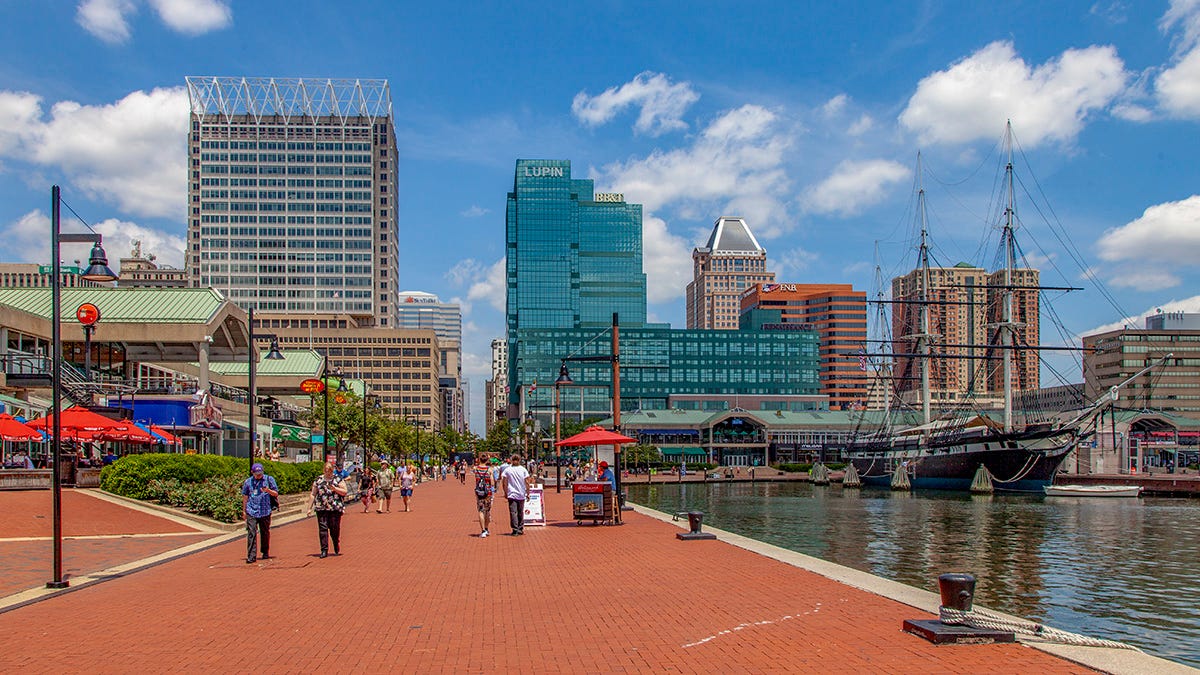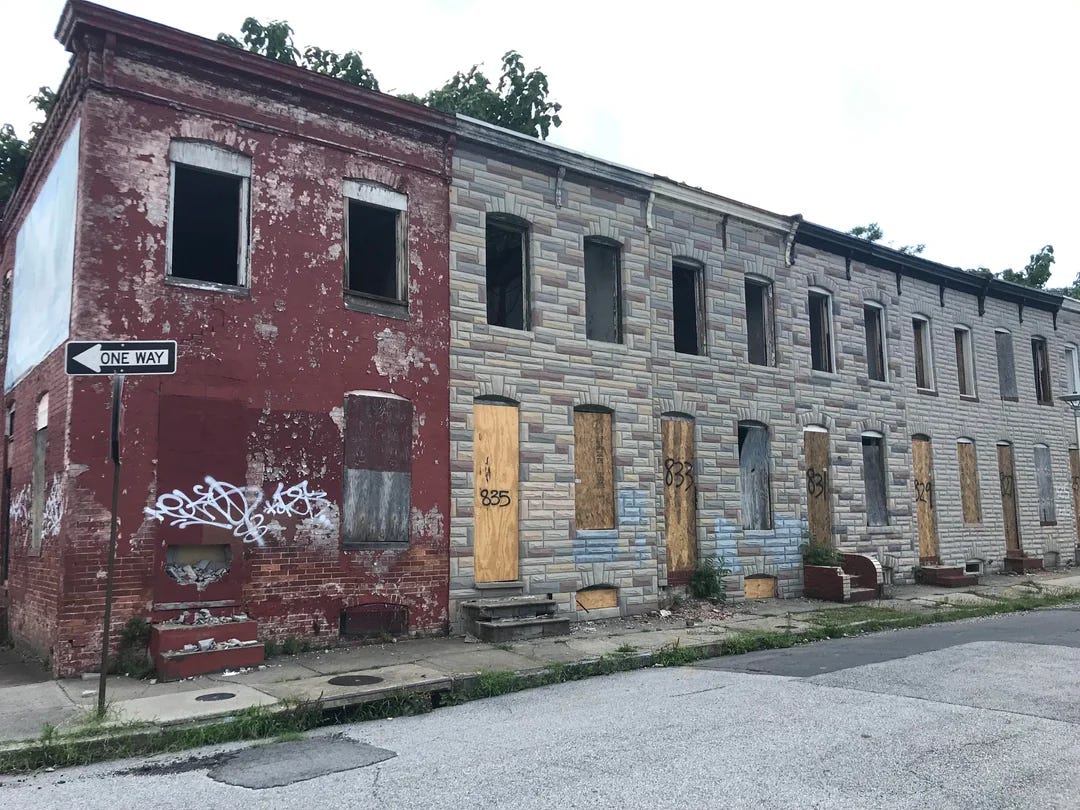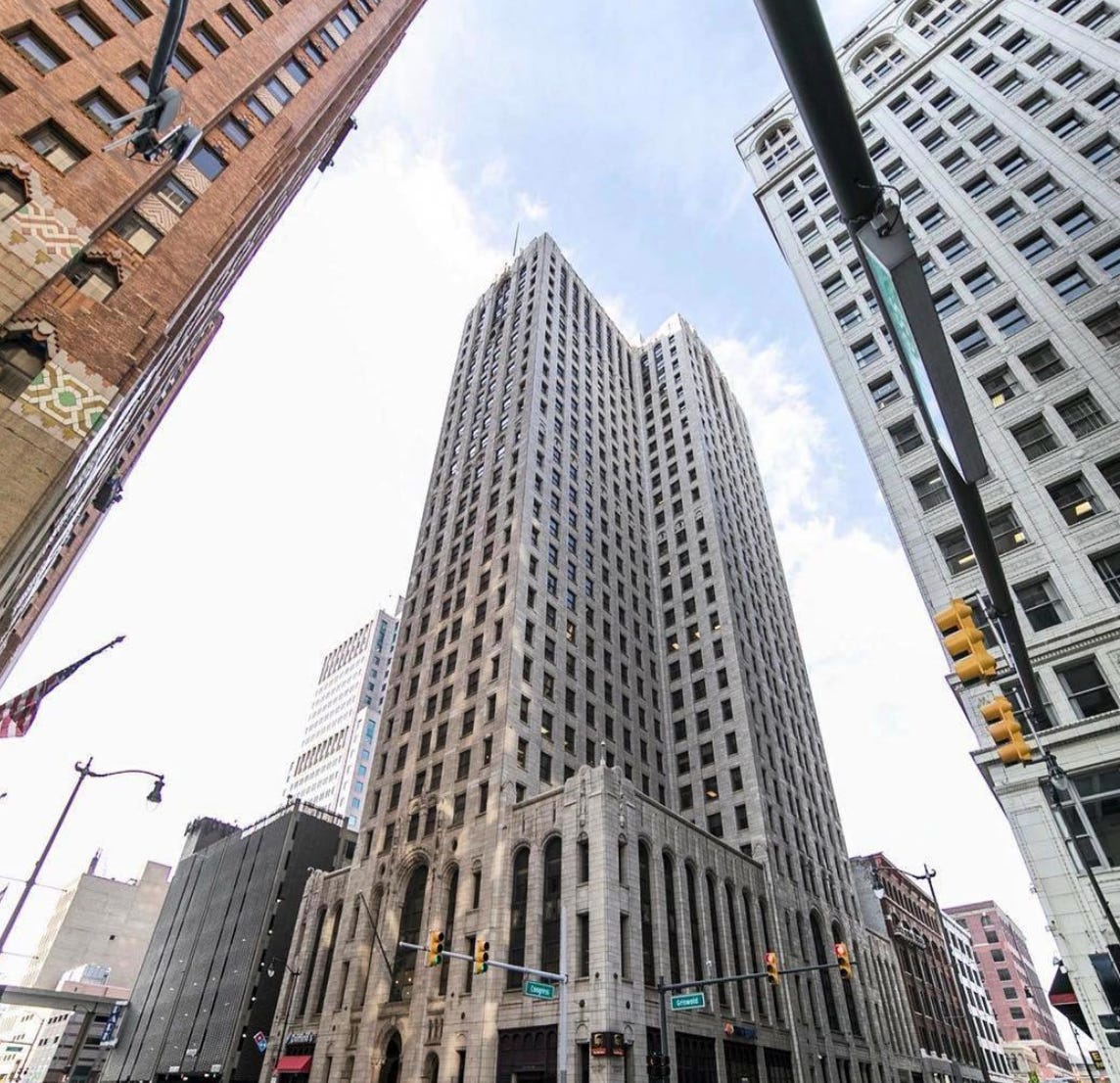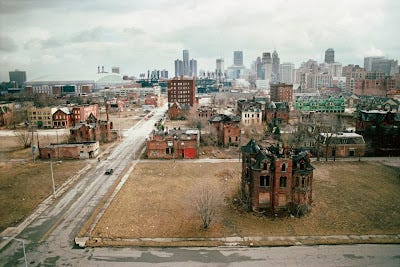Garlic Knot Cities
The centers of these legacy cities are dense and satisfying. The suburbs are doing fine. But what are the neighborhoods in between?
I spent part of last week in Baltimore – the part that everybody likes to go to. I visited the Baltimore Banner, located in a renovated warehouse in the Inner Harbor, stayed at a hotel across the street from Camden Yards, and had a family lunch celebration (my niece graduated from high school) at a fancy steakhouse back in the Inner Harbor.
Thanks for reading The Future Of Where. We rely on readers like you to become paid subscribers to help us continue to product outstandign content. So please consider becoming a free or paid subscriber today.
Not all of Baltimore, of course, is like this. Like many older rust belt cities that have lost population – Philadelphia, Detroit, Cleveland – the suburbs are still growing and the center is getting very strong, but the old city neighborhoods are in rough shape. A mile away from where was enjoying a high-amenity experience, people are trapped in neighborhoods of extreme poverty.
Baltimore’s Inner Harbor
We used to call places like Baltimore and Detroit “donut cities,’ because there was nothing left in the center. But after decades of both public and private revitalization efforts, they’re not really donuts anymore. Some time ago, the Christian urbanist (no, that’s not an oxymoron) Aaron Renn called them “The New Donut,” but that term doesn’t quite fit either.
Instead, I’d call them Garlic Knot Cities – very dense and satisfying in the center, but the center is small and doesn’t have much of substance surrounding it.
Why The Garlic Knot?
It’s important to understand that Garlic Knot Cities are not exactly a failure. In fact, in large part they are a success – as Renn put it in his “New Donut” piece, over the past few decades “pretty much any city or metro region of any size has pumped literally billions of dollars into its downtown in an attempt to revitalize them. This took many forms ranging from stadiums to convention centers to hotels to parking garages to streetcars to museums and more. It’s popular today to subsidize mixed use development with a heavy residential component.”
A rowhouse neighborhood in East Baltimore, a mile or two away from the Inner Harbor.
In Baltimore, the downtown revitalization effort almost 70 years ago with the creation of the downtown Charles Center district, which featured then-popular Modern architecture. The nearby Inner Harbor was revived in the 1980s with James Rouse’s Harborplace, which kicked off a whole national trend toward festival marketplaces. (I remember writing a story in the 1980s about festival marketplaces by focusing on the one in, of all places, Toledo.) Now Harborplace is done for and the folks in Baltimore are trying to figure out what to do next. But in spite of that, Downtown Baltimore continues to do fine.
A great way for you to help expand The Future Of Where’s reach is to share this post with people you know who might like it. That helps us expand our readership and our potential subscription base!
So does suburban Baltimore County, which has picked up an increasing share of the regional population. Baltimore City and Baltimore County are completely separate jurisdictions (the county doesn’t include the city), but together they have a population of about 1.4 million people. That hasn’t changed since 1980. What has changed is distribution of that population. Forty-five years ago, the city’s share was 55% and the county’s was 45%. Today the split is 40-6,0 with the county having added about 200,000 people during that time. (And even so, Baltimore has not suffered nearly the population loss of Cleveland and Detroit.)
The Buhl building in Downtown Detroit, which Dan Gilbert’s Bedrock company is currently renovating.
These population loss figures for legacy cities are not new or surprising. And I would leaven them with two points.
First, households are smaller than they used to be, especially in urban locations. A townhome in a stable Baltimore neighborhood that used to house an entire family with several children might today house only a couple. Meaning that population loss, in and of itself, is not necessarily a sign of distress.
And second, the population loss in these cities has lessened significantly in recent years or even stopped. Baltimore lost population in the 2010s, for example, at only half the rate of the 2020s and is now on a pretty stable trajectory. Detroit, which has lost two-thirds of its population since 1950, has actually gained a few thousand people since 2020.
A residential neighborhood near Downtown Detroit.
Increasingly, the strength of legacy city downtowns and accompanying neighborhoods (often called, as in Detroit, “Midtown”) is not the result exclusively of government action but leadership by private players such as Dan Gilbert, the Rocket Mortgage guy, who also runs a real estate development company called Bedrock. Bedrock has been the most critical player in Detroit’s revival and Gilbert now has big plans for Downtown Cleveland, where he is working with the city on the so-called “shore-to-core-to-shore” plan, which will revitalize and link together the lakefront, downtown, and the riverfront.
But many of the city neighborhoods outside the garlic knot remain in tough shape. I remember a dozen or so years ago, when I was planning director of San Diego, having a startling conversation with my then-colleague in Detroit (there have been several other planning directors in Detroit since, including my Houston friend Antoine Bryant).
The guy didn’t sound like a planner at all. He sounded like a cross between a distressed real estate speculator and a social worker. “My planners’ job,” he said back then, “is to encourage the last grandmother living in the last house on the block to move out so we can raze the house and clear the block.”
But clear the block for what?
Many of these legacy cities were built on the idea of expansive and, at the time, upwardly mobile residential neighborhoods. Baltimore, at 90 square miles, was always a rowhouse town, but Detroit, Cleveland, and to some extent Philadelphia grew by building single-family homes for working-class families at relatively low densities.
Seventy-five years ago, Detroit has 1.9 million people in 140 square miles. Today, the geographical size is the same but the population is a third of what it was. Same for Cleveland.
Over the years, urban planners have come up with all kinds of ideas for what to do with these neighborhoods. (The au courant planning idea for declining Cleveland was, at one point, to turn old neighborhoods into golf courses.) Oftentimes, housing projects – market-rate and affordable – have been built to try to stabilize these neighborhoods but, as a Baltimore friend of mine once said, you can’t build your way out of a housing surplus. And there are any number of outstanding community development organizations that have targeted individual neighborhoods in these cities and are doing yeoman work to help people of modest means be able to own and maintain a single-family home.
In the end, however, cities like Baltimore have wealthy areas, poor areas, and areas where no one lives anymore. As our fertility rates and immigration decline, it seems like this trend is going to continue. So we’re going to have to live with Garlic Knot Cities for quite a while.








Quite an interesting but in the end quite incredible article. A long discussion of the plight of inner cities without a single mention of the real issue. Black violence.
In the US, the primary issue of violence is not associated with immigrants but native black Americans.
We don’t have the assimilation problems caused by Muslims in Europe because Muslims still are a very small percentage of our population.
Luckily for us most of our immigrants are Hispanic who have successfully integrated into our society for centuries.
No the problem is black Americans and especially young black men.
If you have watched The Sopranos you saw the Italian community begin to distance itself from the crime ridden Mafia. When does the apparent tolerance for crime within the black community along with the acceptance by black school administrators of the disruption of classrooms by out of control individuals begin to end? Finally when will fathers who fail to care for and love their children and especially their boy children be openly censured by black leadership? The young Chris Rock joked openly about these issues but he clearly now censors himself.
On X, now without censorship thanks to Elon Musk, out of control violence has become standard fodder for ridicule with blacks typically being the most violent group depicted. Unfortunately, the stereotype of black violence is rooted in reality.
Young black men (15-34) are just 2% of the population yet commit half of the nation’s homicides. A rate an astounding 50 times that of the average American.
Where white people decide to live, shop, vacation and even if they are willing to use public transit (especially women) has been for decades largely based on avoiding large groups of black people because of their perceived and actual tendency to engage in violence. The term white flight in housing patterns has always been used as a disparaging reference when, in truth, it means white common sense. At least touching on this delicate subject as part of the overall discussion would make sense.
Pigs in a blanket cities. Nobody just eats the blanket.